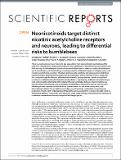Files in this item
Neonicotinoids target distinct nicotinic acetylcholine receptors and neurons, leading to differential risks to bumblebees
Item metadata
| dc.contributor.author | Moffat, Christopher | |
| dc.contributor.author | Buckland, Stephen T. | |
| dc.contributor.author | Samson, Andrew J. | |
| dc.contributor.author | McArthur, Robin | |
| dc.contributor.author | Chamosa Pino, Victor | |
| dc.contributor.author | Bollan, Karen A. | |
| dc.contributor.author | Huang, Jeffrey T. -J. | |
| dc.contributor.author | Connolly, Christopher N. | |
| dc.date.accessioned | 2016-05-12T15:30:06Z | |
| dc.date.available | 2016-05-12T15:30:06Z | |
| dc.date.issued | 2016-04-28 | |
| dc.identifier | 242526646 | |
| dc.identifier | 134f3762-d59e-4ff0-90bd-d07e3fd83ba3 | |
| dc.identifier | 84964886747 | |
| dc.identifier | 000374955900001 | |
| dc.identifier.citation | Moffat , C , Buckland , S T , Samson , A J , McArthur , R , Chamosa Pino , V , Bollan , K A , Huang , J T -J & Connolly , C N 2016 , ' Neonicotinoids target distinct nicotinic acetylcholine receptors and neurons, leading to differential risks to bumblebees ' , Scientific Reports , vol. 6 , 24764 , pp. 1-10 . https://doi.org/10.1038/srep24764 | en |
| dc.identifier.issn | 2045-2322 | |
| dc.identifier.other | ORCID: /0000-0002-9939-709X/work/73701038 | |
| dc.identifier.uri | https://hdl.handle.net/10023/8793 | |
| dc.description | This research was funded jointly by BBSRC, DEFRA, NERC, the Scottish Government and The Wellcome Trust, under the Insect Pollinators Initiative (UK) grant BB/1000313/1(CNC). | en |
| dc.description.abstract | There is growing concern over the risk to bee populations from neonicotinoid insecticides and the long-term consequences of reduced numbers of insect pollinators to essential ecosystem services and food security. Our knowledge of the risk of neonicotinoids to bees is based on studies of imidacloprid and thiamethoxam and these findings are extrapolated to clothianidin based on its higher potency at nicotinic acetylcholine receptors. This study addresses the specificity and consequences of all three neonicotinoids to determine their relative risk to bumblebees at field-relevant levels (2.5 ppb). We find compound-specific effects at all levels (individual cells, bees and whole colonies in semi-field conditions). Imidacloprid and clothianidin display distinct, overlapping, abilities to stimulate Kenyon cells, indicating the potential to differentially influence bumblebee behavior. Bee immobility was induced only by imidacloprid, and an increased vulnerability to clothianidin toxicity only occurred following chronic exposure to clothianidin or thiamethoxam. At the whole colony level, only thiamethoxam altered the sex ratio (more males present) and only clothianidin increased queen production. Finally, both imidacloprid and thiamethoxam caused deficits in colony strength, while no detrimental effects of clothianidin were observed. Given these findings, neonicotinoid risk needs to be considered independently for each compound and target species. | |
| dc.format.extent | 10 | |
| dc.format.extent | 600549 | |
| dc.language.iso | eng | |
| dc.relation.ispartof | Scientific Reports | en |
| dc.subject | QH301 Biology | en |
| dc.subject | GE Environmental Sciences | en |
| dc.subject | DAS | en |
| dc.subject | SDG 2 - Zero Hunger | en |
| dc.subject.lcc | QH301 | en |
| dc.subject.lcc | GE | en |
| dc.title | Neonicotinoids target distinct nicotinic acetylcholine receptors and neurons, leading to differential risks to bumblebees | en |
| dc.type | Journal article | en |
| dc.contributor.institution | University of St Andrews. School of Mathematics and Statistics | en |
| dc.contributor.institution | University of St Andrews. Marine Alliance for Science & Technology Scotland | en |
| dc.contributor.institution | University of St Andrews. Scottish Oceans Institute | en |
| dc.contributor.institution | University of St Andrews. St Andrews Sustainability Institute | en |
| dc.contributor.institution | University of St Andrews. Centre for Research into Ecological & Environmental Modelling | en |
| dc.identifier.doi | 10.1038/srep24764 | |
| dc.description.status | Peer reviewed | en |
This item appears in the following Collection(s)
Items in the St Andrews Research Repository are protected by copyright, with all rights reserved, unless otherwise indicated.

